Chickens are a must-have for any homesteader. Whether you’re raising them for eggs, meat, or as pets, chickens are simply awesome.
That being said, a lot of homesteaders run into the same question when starting their flock – what types of chickens should I buy?
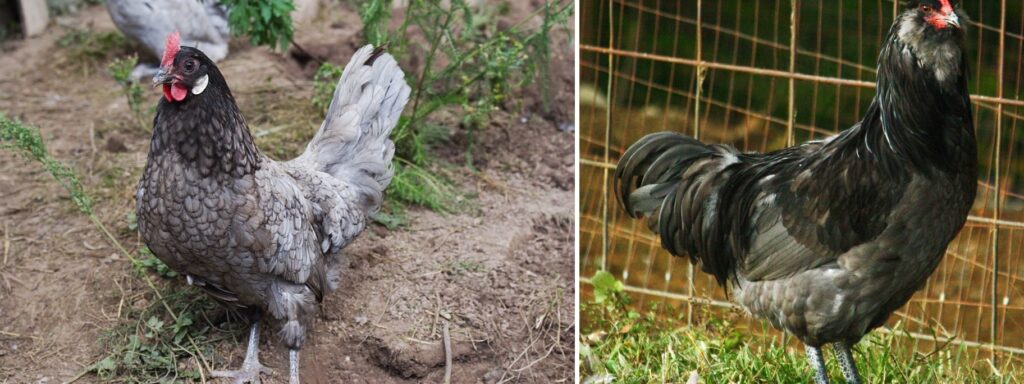
In this guide, we will go through 25 of the most popular chicken breeds along with their purpose (egg-laying, meat, dual-purpose), required experience level, temperament, and much more!
Our Favorite Chicken Breeds – Quick Guide
Interested in a specific breed?
Use the quick links below to jump to any specific section in this article.
| Chicken Breed | Purpose |
| 1. Ameraucana Chickens | Dual |
| 2. Andalusian Chickens | Egg Laying |
| 3. Australorp Chickens | Dual |
| 4. Brahma Chickens | Dual |
| 5. Cochin Chickens | Dual |
| 6. Delaware Chickens | Dual |
| 7. Dominique Chickens | Dual |
| 8. Jersey Giant Chickens | Dual |
| 9. Leghorn Chickens | Egg Laying |
| 10. Maran Chickens | Dual |
1. Ameraucana Chickens
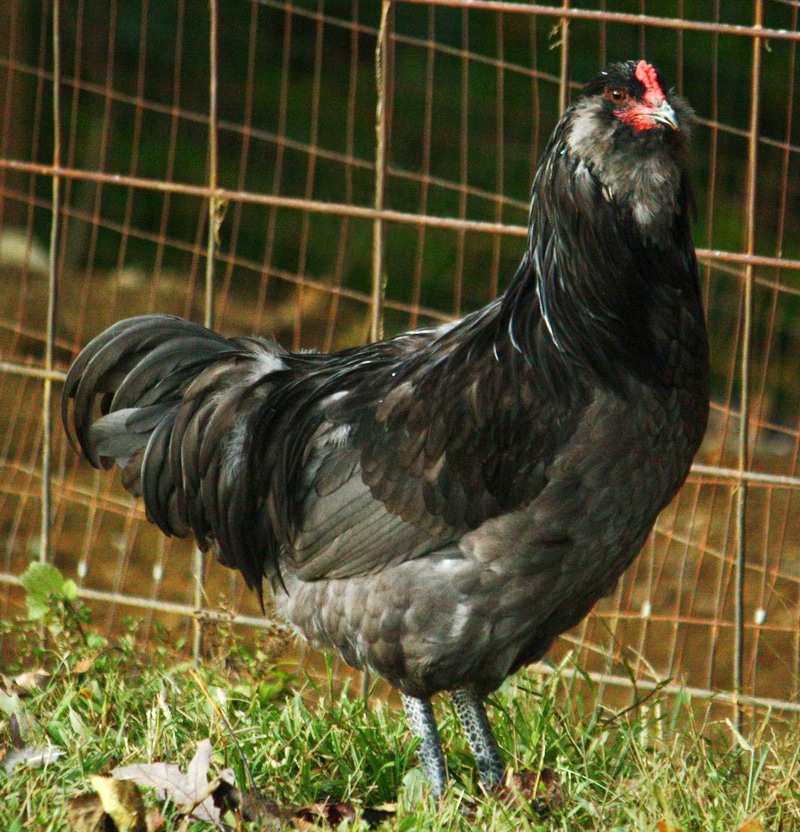
| Egg Production | 3 – 4 large blue eggs per week |
| Egg Laying Age | 6 – 7 months |
| Recommended Experience Level | Beginner |
| Cold/Heat Hardy | Cold hardy/Fairly heat hardy |
| Purpose | Dual |
| Temperament | Docile but can be skittish |
| Size | Hens: 5.5 pounds; Rooster: 6.5 pounds |
| Origin | USA; APA Classification: AOSB (All Other Standard Breeds) |
| Color | Black, Blue, Blue Wheaten, Brown Red, Buff, Silver, Wheaten, White |
| Pricing | Chicks: $10-20/rooster; $20-35/hen; $10/straight-run chicks |
The Ameraucana is a beautiful dual-purpose bird known for its gorgeous light blue eggs.
Ameraucana pullets usually start laying when they’re about six or seven months old and they lay three to four eggs per week.
The American Poultry Association recognizes both the standard and smaller bantam varieties of the Ameraucana.
Whichever size you choose, these birds will add a little spirit and fun to your daily life.
Distinct Features of Ameraucana Chickens
Probably the most distinctive features of the Ameraucana are the feathered cheek muffs and beard.
Another unusual feature is their slate blue- to black-colored legs.
Ameraucanas come in quite a few colors including black, blue, blue wheaten, brown red, buff, silver, wheaten, and white.
They have pea combs and very small wattles and they are considered cold-hardy birds.
The light blue eggs add delightful color to a basket of eggs and they’re always popular with customers.
Although there is no scientific evidence to support the notion that the eggs taste differently, we think the yolks of our Ameraucana eggs taste richer than those of the other breeds.
Size Matters, Especially with Smaller Homestead Producers
The standard Amaraucana hens weigh about 5.5 pounds and the roosters weigh about 6.5 pounds.
Bantam hens weigh about 26 ounces and the bantam roosters weigh about 30 ounces.
One of the great benefits of the Ameraucana’s smaller size is that this bird prefers to roost up high in the rafters.
If you can provide higher roosts for these birds, they can find safety above and you’ll have more room, below, for larger birds to roost.
Handlers who find these birds a bit stand-offish or skittish can try separating them from the larger birds in the flock—the smaller Ameraucanas could simply be protecting themselves from other birds or scary humans.
Homesteaders should start handling these chicks early and often to gain their trust.
Other Things You Should Know About Ameraucanas
- Docile and Fun – The Ameraucana can be a fun bird to raise. They’re usually docile and easy to manage. Some can be quite affectionate and it’s not unusual for a handler to get attached to a particular bird.
- Active Forager –The Ameraucana is fairly active and they love to forage.
- Confinement/Ranging –The Ameraucana handles confinement well but they can be bullied by larger breeds.
- Escaping Predators –Because they can fly, free-ranging Ameraucanas can often escape predators by flying into the trees so be sure they have an escape destination. But over the years, we’ve lost a few Ameraucanas to hawks and the only guarantee is a solid enclosure with overhead protection.
- Fence Hoppers – These birds can hop fences readily so be prepared to let them free-range or create an enclosure that includes a roof or other barrier on top.
- Not Brooders, Typically – The Ameraucana is not particularly known for brooding. A few will do so, but don’t expect this to be a regular event. They’ll be laying eggs while your broody hens are raising the kids. If you would like to raise Ameraucanas, you have several options. You can buy chicks from a breeder. You can also separate your Ameraucana hens and rooster and either hatch their eggs in an incubator or put their eggs under a broody hen such as a Cochin or Brahma.
- Cold Hardy/Fairly Heat Hardy –They are considered a cold-hardy bird. Though they’re not officially considered heat hardy, we’ve never had a problem with our birds. But we keep fans running in the coop full time during the summer and the birds spend a lot of time in the shade on hot days.
- Cuddly if Handled Young –Ameraucanas can be cuddly and sweet. Our friendliest birds have been those who were handled consistently from hatching to adulthood.
For the Homestead Breeder…
The Ameraucana is often confused with the Araucana. The two birds share some common history but there are significant differences.
The Ameraucana is also confused with birds that are often called “Easter Eggers” or “Americanas,” which aren’t recognized breeds of the American Poultry Association (APA) or American Bantam Association (ABA).
Because of the confusion, we recommend that you do your research and buy your Ameraucana chicks or hatching eggs from a reputable breeder.
2. Andalusian Chickens
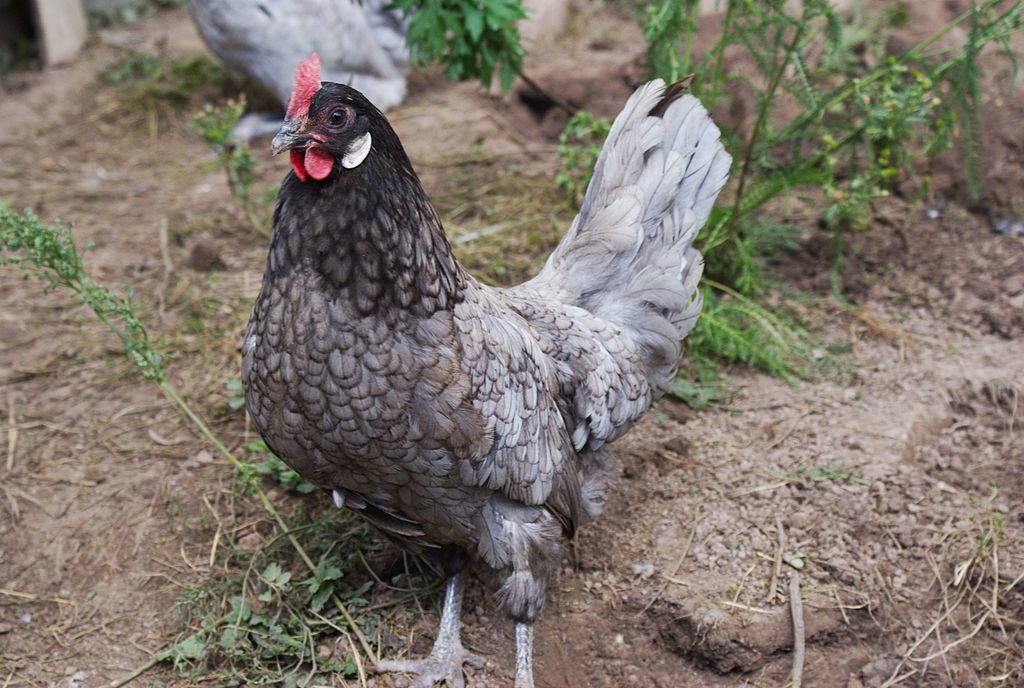
| Egg Production | 155-165 large white eggs per year |
| Egg Laying Age | 5-6 months |
| Recommended Experience Level | Moderate |
| Cold/Heat Hardy | Heat-hardy/Not cold-hardy |
| Purpose | Egg Layer |
| Temperament | Flighty; Noisy; Needs Room to Range |
| Size | Hens: 5-6 pounds. Roosters: 7-8 pounds |
| Origin | Spain/U.K.; APA Classification: Mediterranean |
| Color | Blue, Black, Off-White |
| Pricing | Chicks: $5-$10 for backyard stock |
The Andalusian is a gentle bird used for egg production.
Andalusian pullets start laying when they’re about six months old and lay about three large white eggs per week.
Homesteaders can find Andalusians at various commercial hatcheries. These birds are not of exhibition quality but are fine for egg production.
There are a few breeders producing exhibition-level birds. Becoming a breeder could be a good option for someone looking to produce something different for a niche market.
The Andalusian’s Distinct Features will Grace Any Homestead
The Andalusian has a unique white almond-shaped earlobe and a single comb that should have five distinctive points. The bird is upright with slate blue legs and feet. The skin is white.
The American Poultry Association recognizes only the blue Andalusian but the bird can also occur in black and an off-white color.
The blue feathers should have dark blue or black lace accents on the feather edges.
Andalusians Take it to the Heights of the Homestead
The hens weigh 5 to 6 pounds and the roosters weigh 7 to 8 pounds. Bantam hens weigh about 20 to 24 ounces and the bantam roosters weigh 24 to 28 ounces.
Their smaller size allows them to fly into the trees where they sometimes prefer to roost at night.
If you intend to keep your birds inside at night, you should consider a coop or barn with high rafters where they’ll feel safe.
Andalusians are Reliable Homestead Egg Producers
The Andalusian is a gentle and overall hardy bird. It is not considered cold-hardy yet it is a good wintertime egg producer, taking up the slack when other breeds have slowed their laying.
This breed rarely broods, so homesteaders won’t lose egg production with these hens sitting on eggs.
Of course, there are always exceptions–the occasional Andalusian might hatch out a clutch of eggs.
Other Things Homesteaders Should Know About Andalusians
Active Forager –The Andalusian tends to be fairly active and they love to forage/free-range.
- Escaping Predators –Because they can fly so readily, free-ranging birds can often escape predators by flying into the trees so be sure they have an escape destination. But where predators are concerned, the only guarantee is a complete enclosure.
- Confinement Issues –This is not the best bird for confinement and some resort to feather picking—plucking their coop-mates’ feathers—if they don’t have the opportunity to range.
- Fence Hoppers –These birds can hop fences readily so be prepared to let them free-range or create an enclosure that includes a roof or other barrier on top.
- Noise –This bird can really make a racket when laying eggs. If you have neighbors close by, this will be a consideration.
- Frostbite Susceptibility –The rooster’s large comb is susceptible to frostbite. Deep bedding can help safeguard their legs and feet, which have no feathers. Vaseline can help protect the comb. The Andalusian handles heat reasonably well but its feathering can fade so be sure to provide shade to prevent this.
- Not Cuddly –The Andalusian doesn’t crave human companionship, so if you want a cuddly bird, this breed may not be for you.
Homestead Breeding of Andalusians
Andalusians are readily available through commercial hatcheries. If you are just interested in egg production, these birds will suit you well.
If you are interested in breeding exhibition-quality Andalusians, the color issues can be a bit tricky.
We recommend you buy the chicks or hatching eggs from a reputable and knowledgeable breeder who can help you develop a flock that meets applicable standards.
3. Australorp Chickens
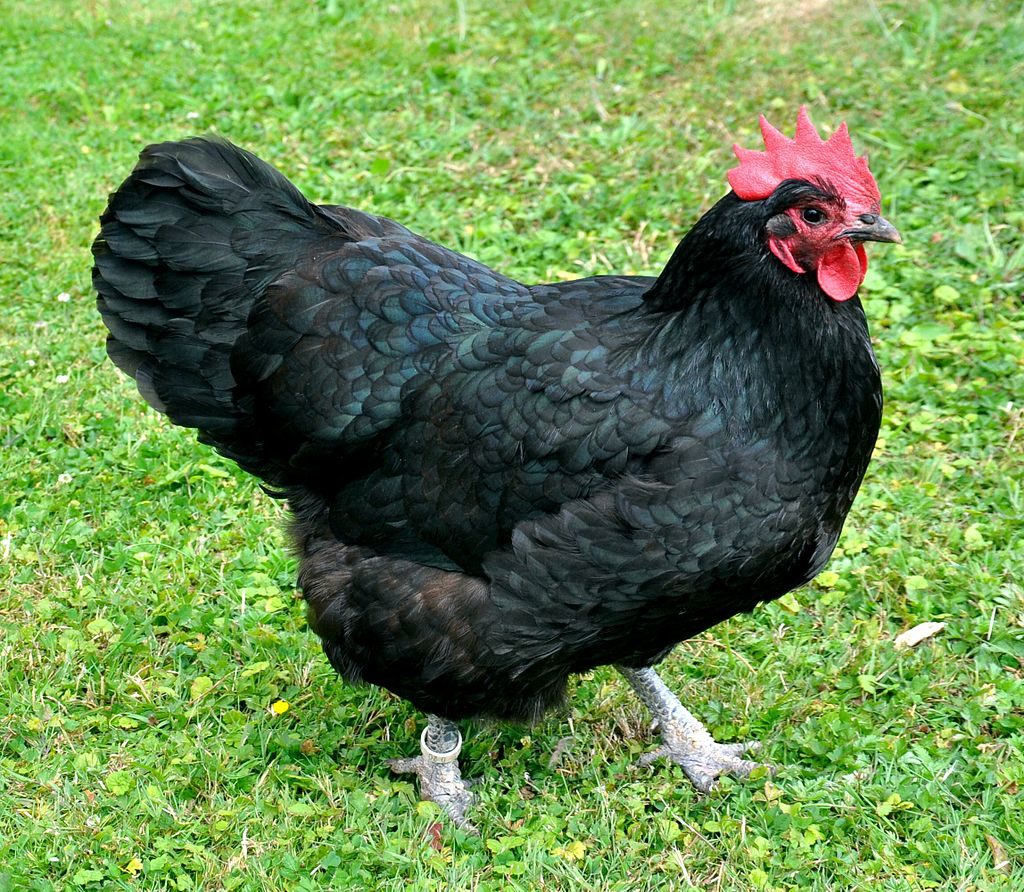
| Egg Production | 5 large brown eggs/week |
| Egg Laying Age | 5-6 months |
| Recommended Experience Level | Beginner |
| Cold/Heat Hardy | Cold Hardy/Fairly Heat-Hardy |
| Purpose | Dual Purpose |
| Temperament | Gentle; quiet; friendly; handles confinement well |
| Size | Hens: 6.5 – 8 pounds; Roosters: 8.5 – 10 pounds; Bantam hens: 1.7 – 2.0 pounds; Bantam Roosters: 2.0 – 2.7 pounds |
| Origin | Australia; APA Classification: English |
| Color | Black (USA); black, blue and white (Australia); black, blue, white, buff, golden, splash, and wheaten laced (South Africa) |
| Pricing | Chicks: $5 for backyard stock |
If you’re looking for a truly prolific egg layer, the Australorp is a great choice.
This large, gentle, dual-purpose bird starts laying at five to six months old and they produce about five eggs per week.
In addition, they also dress out well as meat birds.
The Australorp’s Distinct Features Make Them No-Fuss Homestead Birds
The Australorp is a large black bird. The feathers are a deep black with an iridescent green sheen.
The single comb, with up to seven points, as well as the earlobes and wattles, are a deep red.
These birds have a full, well-rounded breast with solid, full bodies.
The legs are black or slate-blue in color with white-coloring on the bottoms of the feet. The skin is white.
They are considered cold hardy and they handle heat well. They don’t suffer from problems, generally, and are all-around strong productive birds.
The American Poultry Association recognizes only the black Australorp. A bantam version of the Australorp is also recognized in the USA. (In Australia, black, blue, and white Australorps are recognized.
South Africa recognizes the three Australian colors as well as buff, golden, splash and wheaten laced.)
Sizeable Birds for Sizeable Homestead Production
Australorp hens weigh 6.5 to 8 pounds and the roosters weigh 8.5 to 10 pounds. With this size, they dress out well as meat birds.
Bantam Australorp hens weigh 1.7 to 2.0 pounds and the roosters weigh 2.0 to 2.7 pounds.
Other Things Homesteaders Should Know About Australorps
- Docile and Calm –The Australorp is a very calm, gentle bird. Their docile nature makes this breed an exceptional choice for the novice. Roosters and hens, alike, are sweet-natured and easy to handle. The hens can sometimes be bullied when housed with more aggressive breeds but most hold their own. The roosters, on the other hand, are relentless protectors of their hens.
- Active Forager –The Australorp is fairly active and loves to forage.
- Confinement/Ranging –The Australorp handles confinement well. These birds have a tendency to become obese in confinement, however, so homesteaders may have to restrict their feed.
- Escaping Predators –The Australorp is a large bird so they can be at risk with predators. Though they enjoy free-ranging, you’ll want to ensure that their forage area is safe from predators.
- Not Brooders, Typically –Some reports say Australorps are not good egg sitters but, in our experience, a fair percentage of our hens have brooded and hatched out eggs at least once. They make very good mothers.
- Cold Hardy/Fairly Heat Hardy –Australorps are considered a cold-hardy bird. Though they’re not officially considered heat hardy, we’ve never had a problem with our birds. But we keep fans running in the coop full time during the summer and the birds spend a lot of time in the shade on hot days.
- Cuddly if Handled Young –Australorps raised with lots of handling as chicks can be rather cuddly as adults. If they aren’t handled much when young, they’re still friendly but less apt to approach you like a pet.
For the Homestead Australorp Breeder
We’ve had great success with Australorp chicks acquired from commercial hatcheries.
If you’re experimenting with different breeds but you’re on a tight budget, you can probably buy your Australorps from a hatchery and direct more of your experiment dollars toward breeds that really should come from recognized breeders.
4. Brahma Chickens
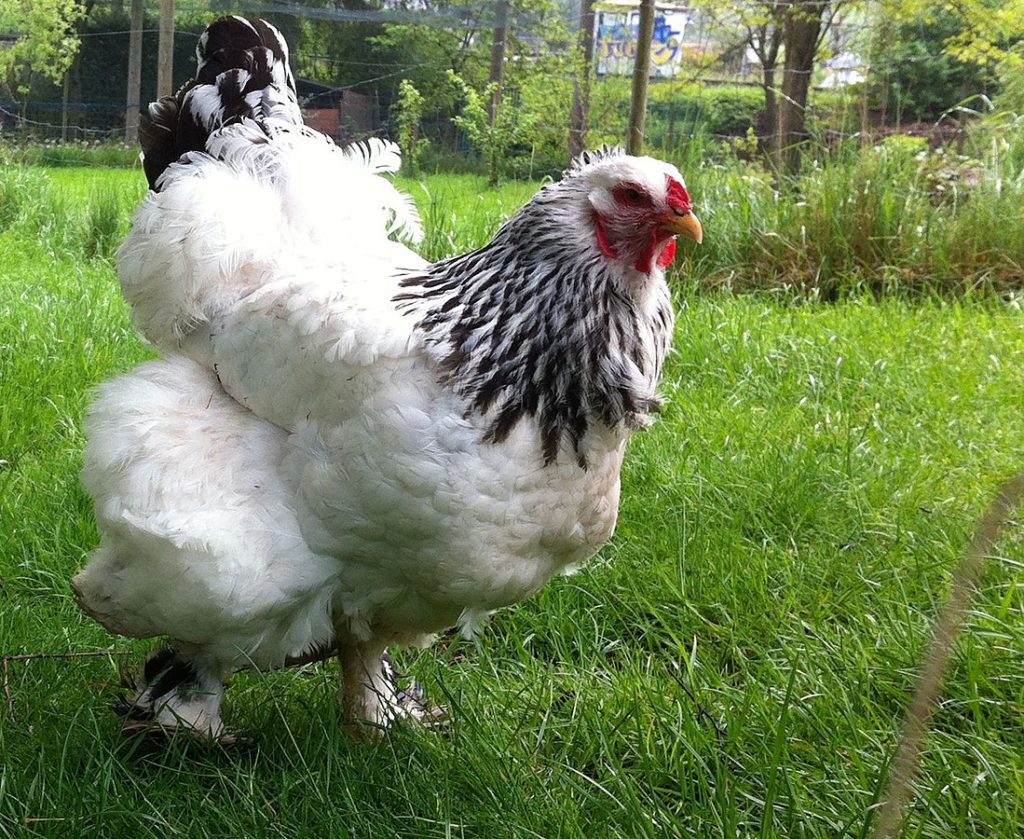
| Egg Production | 3 medium to large brown eggs/week |
| Egg Laying Age | 6-7 months |
| Recommended Experience Level | Beginner |
| Cold/Heat Hardy | Cold Hardy/Somewhat Heat Hardy |
| Purpose | Dual Purpose |
| Temperament | Gentle; quiet; friendly; handles confinement well |
| Size | Hens: 8 pounds; Roosters: 10 pounds; Bantam Hens: 34 ounces; Bantam Roosters: 38 ounces |
| Origin | USA/China/India; APA classification: Asiatic |
| Color | APA recognizes light, dark, and buff. Australia also recognizes barred, black, blue, crele, and partridge |
| Pricing | Chicks: $3-$5 for backyard stock |
The Brahma is a large stately bird, very sweet in temperament, and a delight to have in the flock. This is a dual-purpose bird used for both meat and their medium to large brown eggs. They are cold hardy and, given their size and heavy feathering, they tolerate heat fairly well.
The Brahma’s Distinct Features add Style and Substance to the Homestead
The Brahma is large with feathered shanks and toes, heavy down feathering, and a pea comb, traits that make it particularly suited to cold weather. It has a “beetle brow” characterized by the forehead protruding over the eyes.
The American Poultry Association recognizes three colors: light, dark, and buff. Australia recognizes these as well as barred, black, blue, crele, and partridge.
The Brahma hens weigh about 8 pounds and the roosters weigh about 10 pounds. Bantam hens weigh about 34 ounces and the bantam roosters weigh 38 ounces.
The Brahma Contributes to a Well-Diversified Homestead Flock
Brahmas are rather gawky as youngsters but they eventually grow into stately, elegant adults. Their slow growth means they start producing later in the year than do many other breeds. They are particularly good egg sitters and are often seen brooding in early Summer. They will sit on any eggs the homesteader puts in their nests so they provide an excellent natural means of hatching replacement chicks.
The Brahma is cold-hardy and often produces eggs throughout the winter, taking up the slack when other breeds have slowed their laying. This allows the homesteader to maintain egg production through much of the year. For a well-rounded flock, homesteaders should consider combining the Brahma Summer sitters/Winter layers with some high-volume Summer layers like Australorps and Leghorns.
Other Things Homesteaders Should Know About Brahmas
- Docile and Calm – The Brahma is an exceptionally calm, gentle bird. Their docile nature makes this breed a top choice for the novice. The roosters are amazingly sweet and friendly and easy to incorporate into a flock.
- Confinement/Ranging – The Brahma handles confinement quite well but they enjoy foraging and do well in free-range situations as well. Be sure to provide a sturdy roost a bit lower to the ground in the coop. Brahmas welcome a bit of extra bedding for cushioning on harder floors. Outside, these birds should always have shade available.
- Escaping Predators – Because of its large size, the Brahma might not be able to move quickly enough to escape a predator’s attack. If you allow your Brahmas to free-range, make sure their forage area is safe from predators.
- Not Fence Hoppers – These birds don’t require dramatic fencing as they generally aren’t inclined to escape their enclosures. As with any free-ranging situation, however, make sure the area is predator-free or provide a surround and top cover for protection.
- Quiet Birds –The Brahma hens are very quiet and calm. The roosters will crow occasionally but not constantly.
- Not Frostbite Susceptible – The heavy feathering on the legs and shanks and the small pea comb protect the Brahma from frostbite. As with any breed with feathers on the feet and shanks, wipe off mud in the winter so it doesn’t cake and freeze.
- Cuddly – The Brahma are quite friendly and many enjoy human companionship. We’ve had Brahmas that followed us around like puppies. They sat in our laps and were happy to take a nap there.
- Help Your Broody Hens –Brahma hens should have a little extra room in the nesting boxes, especially when they start to brood. Extra deep bedding and a large brooding box can help reduce the risk of newly hatched chicks being crushed by their oversized mothers.
For the Homestead Brahma Breeder
Unless you’re interested in exhibiting birds, you can find lovely inexpensive Brahma chicks through commercial hatcheries. If you’re experimenting with different breeds but you’re on a tight budget, you can buy your Brahmas from these hatcheries, saving a bit extra for investing in other breeds that should only be acquired through recognized breeders.
5. Cochin Chickens
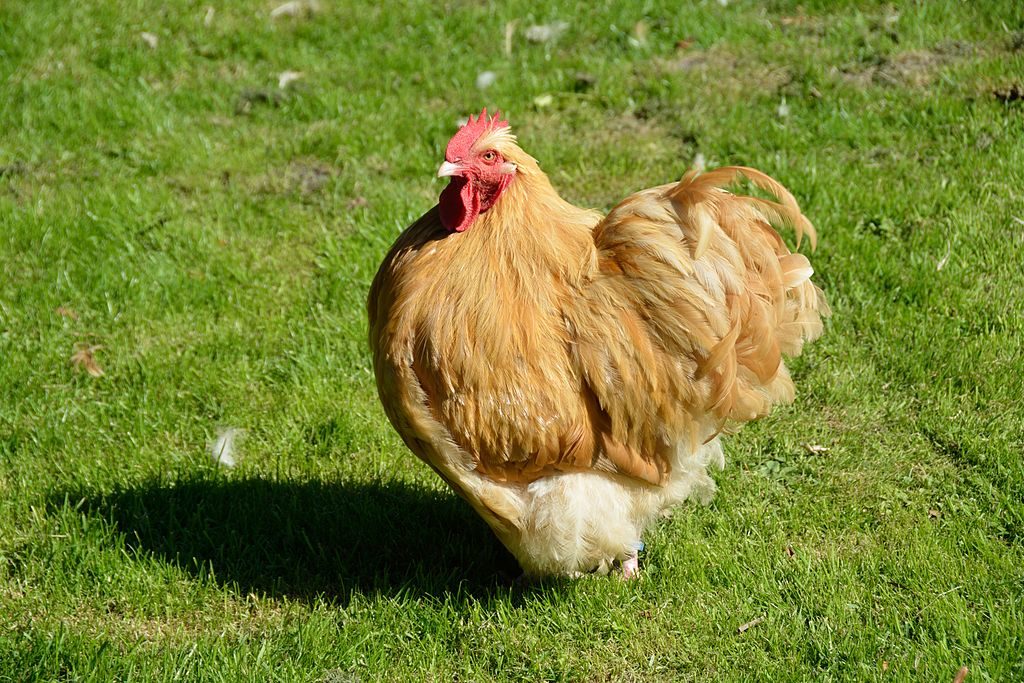
The Cochin is a large, impressive, dual-purpose bird used for both their meat and their medium to large brown eggs. This bird has a very placid, sweet temperament and it has been one of our favorites for years. They are cold hardy and, given their size and heavy feathering, tolerate heat better than expected.
The Cochin’s Distinct Features Fit Any Homestead Situation
The Cochin is large with feathered shanks and toes and heavy down feathering. The pea comb, earlobes and single comb are all red. The legs, toes, and skin are yellow.
The American Poultry Association recognizes quite a few colors: Barred, Black, Blue, Brown, Buff, Golden Laced, Partridge, Silver Laced, and White.
The hens weigh about 8.5 pounds and the roosters weigh about 11 pounds. Bantam hens weigh 800 g (about 28 ounces) and the bantam roosters weigh 900 g (about 32 ounces).
The Cochin is an Outstanding Sitter and Winter Provider of Eggs
Cochins do not start laying eggs until they reach about 8 months of age. Though not prolific layers, they lay during the winter when other breeds have slowed or stopped their egg production. This helps the homesteader maintain egg production through much of the year. For continuous egg production, homesteaders can combine Cochins with high-volume Summer layers like Australorps and Leghorns.
Where the Cochin really shines, however, is in the brood nest. The Cochin hen broods almost every year, often more than once, so they are an outstanding natural means of hatching replacement chicks on the homestead. They are happy to accept eggs from other hens and they’ll mother them quite well. It’s always delightful to see a Cochin mother raising a brood of different breeds.
Other Things Homesteaders Should Know About Cochins
- Docile and Calm –The Cochin is wonderfully calm and gentle, making this bird an excellent choice for the novice. The roosters are amazingly sweet and friendly and easy to incorporate into a flock though their bantam counterparts can be scrappy and aggressive.
- Moderate Forager –Cochins are happy to go out and forage but don’t expect them to engage in significant activity. They should always have shade available.
- Confinement –The Cochin’s placid nature allows them to handle confinement exceptionally well. Given their size, be sure to provide roosts a bit lower to the ground. They welcome a bit of extra bedding for cushioning on harder floors.
- Escaping Predators –The Cochin’s large size prevents them from moving quickly so these birds can be a ready target for predators. If you allow them to free-range, make sure their forage area is safe from predators.
- Fence Hoppers –These birds aren’t likely to hop fences but, as with any free-ranging situation, make sure the area is predator-free or provide a surround and top cover for protection.
- Quiet Birds –Cochins are very quiet birds. The roosters will join in with the morning crowing but the hens go about their business without fuss.
- Not Frostbite Susceptible –Cochins are built for cold weather. The heavy feathering on the legs and shanks and the small pea comb protect them from frostbite. As with any breed with feathers on the feet and shanks, wipe off mud in the winter so it doesn’t cake and freeze.
- Cuddly –Docile, with a very sweet, gentle, calm temperament, these birds are happy to be handled. We’ve had quite a few Cochins who became lap chickens and some even came into the house from time to time.
- Oversize their Structures – The Cochin’s larger size requires some accommodation. They should have a little extra room in the nesting boxes, especially when they start to brood, along with extra deep bedding, which will help reduce the risk of newly hatched chicks being crushed by their oversized mothers. They need lower, extra sturdy roosts.
For the Homestead Cochin Breeder
Unless you’re interested in exhibiting birds, you can find lovely inexpensive Cochin chicks through commercial hatcheries. If you’re experimenting with different breeds but you’re on a tight budget, you can buy your Cochins from a hatchery and apply the savings toward investing in other breeds that should only be acquired through recognized breeders.
6. Delaware Chickens
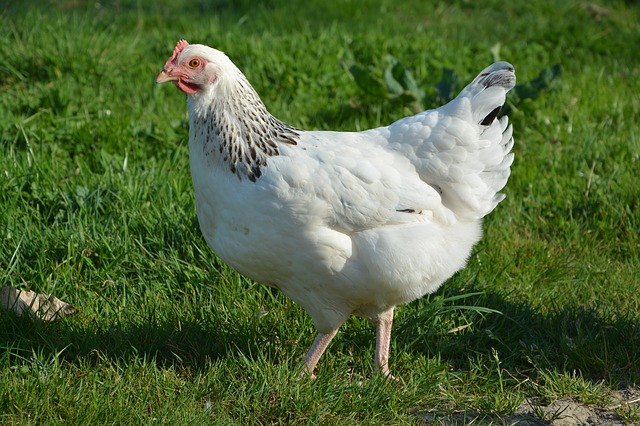
| Egg Production | 3-4 large brown eggs/week |
| Egg Laying Age | 5-6 months |
| Recommended Experience Level | Beginner |
| Cold/Heat Hardy | Cold hardy/Fairly heat hardy |
| Purpose | Dual Purpose |
| Temperament | Gentle; quiet; friendly; handles confinement well but prefers to forage |
| Size | Hens: 6 – 6.5 pounds; Roosters: 7 – 8.5 pounds; Bantam hens: 28 ounces; Bantam Roosters: 32 ounces |
| Origin | USA; APA Classification: American |
| Color | White with barred black feathers on the tips of its hackles, wings, and tail |
| Pricing | Chicks: $4- $5 for backyard stock |
The Delaware is a dual-purpose bird that offers fast meat growth, a striking appearance, and good egg production. The breed was created in the 1940s by crossing a Barred Plymouth Rock rooster with a New Hampshire hen.
Once the top meat bird on the east coast of the USA, this bird has fallen off the radar of many who raise chickens. It deserves a comeback and there are a few breeders dedicated to bringing the Delaware back to prominence.
The Delaware starts laying at five to six months of age. They produce three to four large brown eggs per week. And they shine as meat birds with a large breast, well developed thighs and legs, and a beautiful yellow skin.
The Delaware’s Distinct Features—A Striking Addition to Any Flock
The Delaware is instantly-recognizable with only one color pattern that the American Poultry Association recognizes. It is predominantly white with barred black feathers on the tips of its hackles, tail and wings. It has yellow legs and skin. The single comb and wattles are red.
Delawares are considered cold hardy and they can handle heat fairly well. They are generally disease-free and strong productive birds.
Excellent Meat Birds That Add Several Eggs Per Week
Delaware hens typically weigh between 6 and 6.5 pounds and the roosters weigh from 7 to 8.5 pounds. Bantam Delaware hens weigh 28 ounces and the roosters weigh 32 ounces.
The Delaware’s fast growth and fine meat quality makes it a worthwhile addition to any flock. Its ability to produce several eggs a week adds significant versatility to any flock.
Other Things Homesteaders Should Know About Delawares
- Docile and Calm –The Delaware is a very calm, gentle bird. Their docile nature makes them an excellent choice for those just starting out with chickens. Both roosters and hens are quiet and easy-going but the roosters are particularly good flock guardians.
- Active Forager –The Delaware is fairly active and loves to free-range/forage. They dig a lot, so consider moving their foraging area regularly.
- Confinement/Ranging –Delawares handle confinement well but they really love free-ranging. If you allow them to forage within a large enclosure, they generally accept containment and don’t try to hop their fences.
- Escaping Predators –Because the Delaware accepts fencing so readily, you should be able to protect them from most predators. Be sure to give them overhead protection from hawks. Overall, these birds are smart and wary of predators. Your Delaware rooster will be very protective of his hens, even against hawks.
- Mixed Brooders –Some Delawares brood and some don’t. Their calm nature and smaller size make those who want to brood easy to accommodate. They’re happy in a fairly small area and their lower weight makes them less likely to crush their eggs or chicks.
- Cold Hardy/Fairly Heat Hardy –The Delaware is considered cold hardy but its larger comb can be susceptible to frostbite. The breed can handle heat, but be sure to provide shade at all times.
- Mixed on Cuddliness –Although the Delaware is calm and gentle, it isn’t generally considered a cuddly bird. But we’ve had a few Delawares that seemed quite happy to sit in our laps. They tend to be rather chatty and nosy, actually, always wanting to know what you’re doing, and sometimes getting underfoot as they tell you how their day is going. It’s rather endearing and several of our Delawares have become lovely pets. As with any bird, the more you handle it as a youngster, the more likely you’ll have a bird that looks forward to being handled.
For the Homestead Delaware Breeder
For small egg and meat production, chicks from commercial hatcheries should work for you. If you want to breed this chicken, however, you should buy your breeding stock from an experienced breeder who has been working on improving the strains available. This is one of those breeds worth spending some money on if you want to exhibit or become a breeder.
7. Dominique Chickens
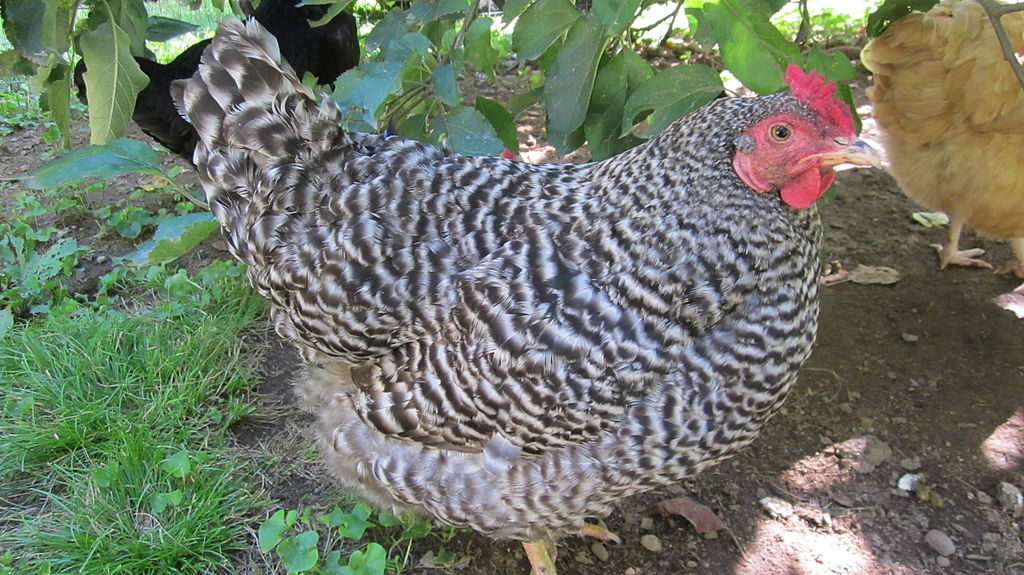
| Egg Production | 4-5 small to medium eggs/week |
| Egg Laying Age | 6 months |
| Recommended Experience Level | Beginner |
| Cold/Heat Hardy | Cold Hardy/Fairly Heat-Hardy |
| Purpose | Dual Purpose |
| Temperament | Gentle; quiet; friendly; handles confinement well but loves to forage |
| Size | Hens: 5 pounds; Roosters: 7 pounds; Bantam Hens: 26 ounces; Bantam Roosters: 28 ounces. |
| Origin | USA; APA Classification: American |
| Color | Dark and light grey barring |
| Pricing | Chicks: $5 for backyard stock |
The Dominique—often called the Dominicker—has been an important part of America’s history and is considered America’s original chicken breed. This gentle, dual-purpose bird is hardy and an easy keeper.
Dominque hens mature quickly and start laying eggs at six months of age. They produce four to five small- to medium eggs per week. Though not large, these birds are also used for meat.
The Dominique’s Distinct Features: Hardy Easy Keepers for Homesteaders
The Dominique is a medium-sized bird with a red rose comb with a leader. The earlobes and wattles are also red. The skin and legs are yellow.
Dominiques can be confused with Plymouth Barred Rocks, but there is a distinct difference in the plumage. The feathers of the Dominique are barred grey and white/light grey, often with darker edges. The barring occurs in an irregular pattern which distinguishes this bird from the more uniformly barred Plymouth Barred Rock. The Plymouth Barred Rock’s feathers are also black and white, versus the Dominique’s shades of grey.
The Dominique is considered cold hardy. The breed handles heat well. This is an overall hardy bird not known for physical ailments or problems.
The American Poultry Association recognizes only the one color for Dominiques: the irregular barred dark and light grey feathering. A bantam version of the Dominique is also recognized in the USA.
Smaller Size, Smaller Feed Bills on the Homestead
Dominique hens grow to about five pounds while the roosters reach about seven pounds. The Dominique bantam hens weigh 26 ounces and the bantam roosters weigh about 28 ounces.
The smaller size means lower feed requirements for these birds relative to many of the other breeds. In addition, these birds are top foragers which also reduces the amount of feed that must be provided.
Other Things Homesteaders Should Know About Dominiques
- Docile and Calm Hens – The Dominique hens are very calm, gentle birds. Their docile nature makes this a terrific breed for the beginner. They do especially well with other gentle breeds but larger, more aggressive breeds can bully these chickens. Dominique roosters can be aggressive and reportedly have killed intruders such as snakes, rats, and even small cats.
- Active Forager – Dominiques are known for their self-sufficiency and ability to forage.
- Confinement/Ranging – The Dominique handles confinement well and likes to roost higher up. But given a choice, these birds are natural foragers and they’ll spend hours every day happily scratching for bugs, berries, and other edibles. They do fine in portable chicken tractors with a nice-sized enclosure.
- Escaping Predators – The Dominique is fairly small and nimble so they have a decent chance of escaping predators. But given their strong preference for free-ranging, you’ll want to ensure that their forage area is safe from predators.
- Decent Brooders – The Dominique historically was the American farm’s primary chicken breed. Back then, hatcheries weren’t available and farmers counted on the hens to reproduce and raise replacement chicks. This trait remains viable and at least some of your Dominiques will likely go broody during the summer. They are quite diligent when they brood. They make good protective mothers and lead their chicks around the farm with confidence.
- Cold Hardy/Fairly Heat Hardy – Dominiques are considered a cold-hardy bird. They also tolerate heat and humidity well, making them good all-around birds. Because they’re such active foragers, they should have shade available in hotter months.
- Friendly if not Cuddly Birds – Dominiques are curious chickens and are relaxed and friendly. They’ll follow their humans around the property with their baby chicks in tow. They may not hop into your lap but they tolerate regular handling.
For the Homestead Dominique Breeder
Dominiques are among the easiest keepers available. Commercial hatcheries offer these birds inexpensively, though the birds might not be to standard. This breed produces smaller eggs when compared with many of today’s breeds but they do produce quite a few of them. If you are interested in raising these birds to standard, you should find a reputable breeder who can provide breeding stock.
8. Jersey Giant Chickens
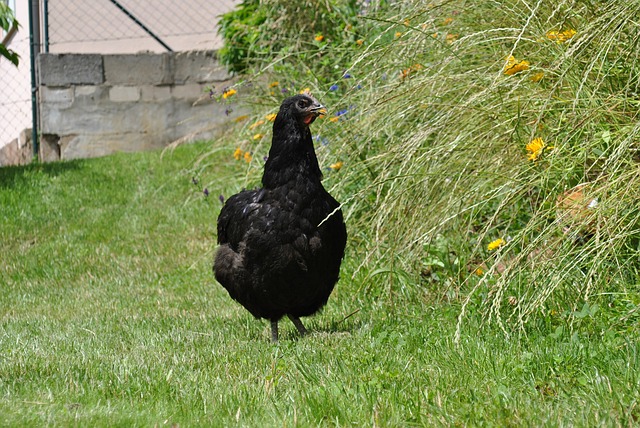
| Egg Production | 3-4 extra large/jumbo brown eggs/week |
| Egg Laying Age | 6 months |
| Recommended Experience Level | Beginner |
| Cold/Heat Hardy | Cold Hardy/Not particularly heat hardy |
| Purpose | Dual Purpose |
| Temperament | Calm, gentle; quiet; friendly; handles confinement well |
| Size | Hens: 10 pounds; Roosters: 13 pounds; Bantam Hens: 34 ounces; Bantam Roosters: 38 ounces |
| Origin | USA; APA classification: American |
| Color | APA recognizes Black, White, and Blue |
| Pricing | Chicks: $4-$5 for backyard stock |
The Jersey Giant is, indeed, a giant. It is the largest purebred chicken breed and is used for both its extra-large brown eggs and its meat.
The Jersey Giant’s Distinct Features—Stately in All Colors
The American Poultry Association recognizes three colors for the Jersey Giant: black, white, and blue. There is also a splash colored variety that isn’t officially recognized. Regardless of color, these are big, strong, stately birds.
The black Jersey Giant has black feathers with a brilliant beetle green iridescent sheen. Its legs are black. The white Jersey Giant has white feathers and willow-colored leg shanks. The blue Jersey Giant has slate blue feathers with dark lacing and dark leg shanks. The shanks can range from a dark willow color to almost black.
The undersides of the Jersey Giant’s feet are yellow. The skin is also yellow. The single comb has six points and is red. The wattles are red as well. The bird has clean legs.
The hens weigh ten pounds and the roosters weigh thirteen pounds. Bantam hens weigh 34 ounces and the bantam roosters weigh 38 ounces.
The Jersey Giant is a True Dual-Purpose Bird for the Homestead
Jersey Giants start laying eggs at approximately six months of age. They produce anywhere from 135 to 200 brown eggs per year which works out to three to four eggs per week. Their eggs are very large. Jersey Giants often continue to lay during the winter when other breeds take a break.
This bird grows fast but is fairly slow to mature. The teenagers can look a bit gawky until they fill in. Some birds don’t mature fully for a year or more but most are ready for the table within eight or nine months. An excellent roaster, this bird is tender and delicious.
Other Things Homesteaders Should Know About Jersey Giants
- Docile, Calm, and Gentle –The Jersey Giant is wonderfully calm, docile, and gentle. A beginner can raise these birds with confidence. They are not flighty but they can be somewhat active for their size.
- Good Forager –Jersey Giants are good foragers. They need a lot of nutrition so foraging helps keep the feed bill lower.
- Confinement –The Jersey Giant’s placid nature allows them to handle confinement well. Given their size, be sure to provide sturdy roosts a bit lower to the ground. They welcome a bit of extra bedding for cushioning on harder floors.
- Escaping Predators –The Jersey Giant’s large size cuts both ways. Hawks are less likely to attack them because they are so large. But that large size can limit how fast they can move to escape a predator of the four-legged persuasion. If you allow them to free-range, make sure their forage area is safe from predators.
- Not Fence Hoppers –These birds aren’t likely to hop fences but, as with any free-ranging situation, make sure the area is predator-free or provide a surround and top cover for protection. When faced with a predator, this bird can manage flight to some extent.
- Generally Cold Hardy –Jersey Giants are considered cold hardy but their single comb can be susceptible to frostbite.
- Cuddly –The Jersey Giant is a big lovable bird. They’re so calm, sweet, gentle, and docile that some keep them as pets. We’ve had a couple of Jersey Giants that were so happy to be held that they would be among the first to greet us in the morning and hop in our laps even while the other birds were busy eating treats.
- Not Overly Broody –The Jersey Giant will brood sometimes but they are so big that they tend to break their eggs. If they do brood, provide oversized nesting boxes and extra deep bedding. You can always put your Jersey Giant eggs under a Cochin or other broody hen who has a better chance of hatching them out.
For the Homestead Jersey Giant Breeder
Jersey Giant chicks are available inexpensively through commercial hatcheries. Sometimes these birds might not grow quite as large as do the birds from a breeder, but they do really well, producing outstanding eggs and meat.
9. Leghorn Chickens
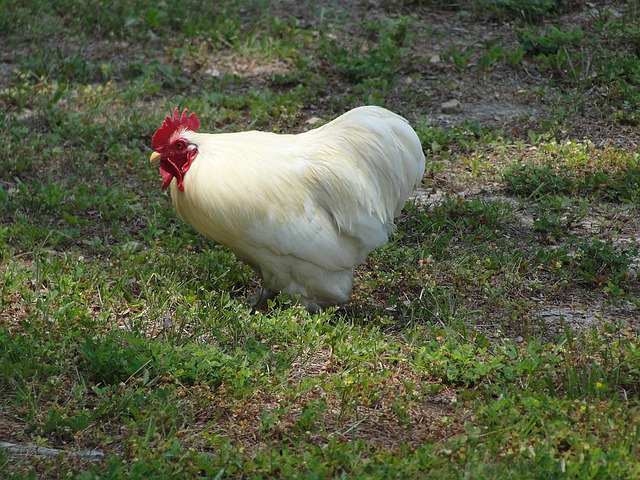
| Egg Production | 4 – 6 large/extra-large white eggs per week |
| Egg Laying Age | 6 months |
| Recommended Experience Level | Beginner |
| Cold/Heat Hardy | Cold hardy/Fairly heat hardy |
| Purpose | Eggs |
| Temperament | Active, nervous, busy forager |
| Size | Hens: 4 – 5 pounds; Rooster: 6 pounds; Bantam Hens: 22 ounces; Bantam roosters: 26 ounces |
| Origin | Italy/USA/UK/Denmark; APA Classification: Mediterranean |
| Color | Single Comb: Dark Brown, Light Brown, White, Black, Buff, Silver, Red, Black Tailed Red, Columbian, Golden. Rose Comb: Dark Brown, Light Brown, Buff, Silver, Black, White |
| Pricing | Chicks: $4 -$5 from a hatchery |
The Leghorn is a very active egg-producing machine. Leghorn pullets usually start laying when they’re about six months old and they often lay five or more large to extra-large white eggs per week. These are fairly self-contained birds that a beginner can maintain.
Both the standard and smaller bantam versions of the Leghorn are officially recognized. Whichever size you choose, these birds will add lots of eggs and entertainment to your homestead.
Distinct Leghorn Features for Productive Homesteads
Leghorns come in two primary varieties: those with single combs and those with rose combs. Many are surprised to learn that Leghorns come in far more colors than white. The American Poultry Association recognizes several colors in the single comb variety including dark brown, light brown, white, black, buff, silver, red, black tailed red, Columbian, and golden. For the rose comb variety, the APA recognizes dark brown, light brown, buff, silver, black, and white.
The Leghorn has yellow legs and yellow skin. The combs and wattles are red. The single comb has five distinctive points and is often so large that it tends to flop over, giving the bird a rather comical appearance. The rose comb is more reserved with small rounded points.
The hens weigh four to five pounds and the roosters weigh about six pounds. The bantam hens weigh 22 ounces and bantam roosters weigh 26 ounces.
The Highly Active Leghorn Adds Great Productivity and Entertainment
The Leghorn is fast-maturing, hardy, and robust. This bird may be small, but it’s tough and scrappy. This is a healthy breed with no known problems.
Leghorns stay busy and their antics provide hours of amusement. They are constantly foraging, scratching, running around the barnyard, and watching everything around them.
With five or more eggs per week from each bird, the Leghorn is a welcome addition to any flock. They offer an excellent egg to feed ratio, especially if they’re allowed to forage.
Other Things Homesteaders Should Know About Leghorns
- Not Docile but Loads of Fun – The Leghorn can be a fun bird to raise. They’re not docile or calm—in fact, they can be somewhat flighty and nervous—but their productivity and entertainment value more than makes up for this.
- Active Forager – The Leghorn is very active and loves to forage. If there is food out there, your Leghorn will find it.
- Confinement/Ranging – The Leghorn can handle confinement but really prefers to be out and about, foraging. If they must be confined, be sure to add some toys and buddies to the coop to accommodate their need to stay busy.
- Escaping Predators – Leghorns are good flyers and they often roost in trees. They are quick and can escape many predators but their small size is particularly attractive to hawks and eagles. We’ve been fortunate in that we’ve never lost a Leghorn to a hawk but the only guarantee is a solid enclosure with overhead protection.
- Fence Hoppers – These birds can hop fences readily so be prepared to let them free-range or create an enclosure that includes a roof or other barrier on top.
- Not Brooders – The Leghorn is not a good brooder but they’ll be laying plenty of large and extra-large eggs while your broody hens are raising the kids. You can buy more chicks or, if you breed Leghorns, you can hatch their eggs in an incubator or put their eggs under a broody hen such as a Cochin or Brahma.
- Noisy – Leghorns can be quite talkative and they tend to cackle.
- Cold Hardy/Fairly Heat Hardy – Leghorns are cold hardy and tolerate heat well. The single comb can be susceptible to frostbite, however.
- Not Cuddly – Leghorns are too busy to be cuddly. But they’re so entertaining that most people don’t mind. Handling them helps, but these birds aren’t going to be lap chickens.
For the Homestead Breeder…
The Leghorn is a highly productive egg layer and a great source of entertainment. Various colors are available inexpensively from hatcheries and these birds work out quite well in homestead flocks.
10. Marans Chickens

| Egg Production | 3 to 4 dark brown eggs/week |
| Egg Laying Age | 6 months |
| Recommended Experience Level | Novice for backyard flock; Moderate for breeders |
| Cold/Heat Hardy | Cold Hardy/Somewhat Heat-Hardy |
| Purpose | Dual Purpose |
| Temperament | Docile, friendly, passive, very clean; somewhat active but handles confinement well |
| Size | Hens: 6.5 pounds; Roosters: 8 pounds; Bantam hens: 32 ounces; Bantam Roosters: 38 ounces |
| Origin | France; APA Classification: Continental |
| Color | APA recognizes black copper, wheaten, and white |
| Pricing | Chicks: $5 from hatcheries but $15 to $50 or more for quality breeding stock |
The Marans is a dual-purpose chicken. These fast-growing birds lay three to four dark brown eggs per week and also produce good quality meat. But most people know this bird for its dark eggs. The darkness of the egg tends to vary with the season, diet, and other factors, and some eggs have spots. Marans egg color is evaluated on a scale of 1 to 9.
Distinct Features of the Marans
APA recognition of the Marans is fairly recent. Currently, the APA recognizes three Marans colors: black copper and wheaten, which were recognized in 2011, and white, which was recognized in 2014. France recognizes several additional colors and there are some unrecognized colors here and there as well.
There are both clean-legged and feathered-legged Marans available but the APA only recognizes the feathered-leg variety. The feathering on the shanks is not as heavy as it is with breeds like Brahmas or Cochins.
The Marans has slate colored or pink shanks. The skin and soles of the feet are white. The single comb, with five or more points, as well as the earlobes and wattles, are red.
Marans hens weigh about six and a half pounds and the roosters weigh about eight pounds. Bantam Marans hens weigh 32 ounces and the roosters weigh 38 ounces.
The Marans is considered cold hardy and they handle heat somewhat well. Overall, this is a strong, hardy breed.
Other Things Homesteaders Should Know About Marans
- Docile and Calm – The Marans is a docile and gentle bird. They tend to be gentle and easygoing, though some report that some roosters can be aggressive with other roosters. Generally, Marans tend to get along with birds of other breeds and do well in mixed flocks.
- Active Forager – The Marans is fairly active and loves to forage. But Marans are often the first birds to return to the coop at night, a trait that some equate with passivity and lower egg production.
- Confinement/Ranging – The Marans handles confinement well. Because they return to the coop early at night, they often get their choice of roosting spot. Though they’re not overly large, they appreciate sturdy roosts that aren’t particularly high up.
- Escaping Predators – The Marans is sizeable and docile enough that they are at risk with predators. They love to forage but they might not be able to get away from a determined predator, so provide a safe predator-proof foraging area for them.
- Decent Brooders – Marans vary with a fair number of them brooding while some never brood. This broodiness is a factor in the average number of eggs a hen will lay each year. They tend to be good mothers.
- Cold Hardy/Somewhat Heat Hardy – Marans are considered a cold-hardy bird. In colder climates, however, be sure to watch out for frostbite on the comb. They take time off from laying during the heart of winter, but when they resume laying, their eggs are especially dark. Though they’re not officially considered heat hardy, we’ve never had a problem with our birds. But we keep fans running in the coop full time during the summer and the birds spend a lot of time outside in the shade on hot days.
- Not Particularly Cuddly – Marans are friendly enough but they’re not particularly cuddly. If handled right from the start, they tend to be more inclined to tolerate handling than those who aren’t handled. These birds can be curious, however, and might follow you around, probably in hopes of getting a treat or two.
For the Homestead Marans Breeder
Marans chicks are available from hatcheries for $5 or $6 each. But if you are serious about breeding these birds to standard, you’ll want to spend some of your money for foundation stock. Chicks from birds that meet APA standards can cost as much as $60 each and are often rated based on the color of the bloodline’s eggs. Marans may be a dual purpose bird, but it’s really all about egg color.
A novice can raise these birds. But if you want to be a serious breeder, Marans can be very tricky because of the various issues relating to egg color and egg production and the difficulties of breeding to meet the standard.
11. Orpington Chickens
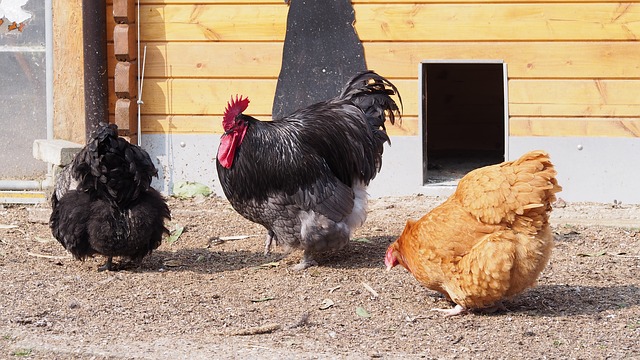
| Egg Production | 4-5 large brown eggs/week |
| Egg Laying Age | 6 months |
| Recommended Experience Level | Beginner |
| Cold/Heat Hardy | Cold Hardy/Fairly Heat-Hardy |
| Purpose | Dual Purpose |
| Temperament | Docile; gentle; quiet; friendly; calm; handles confinement well |
| Size | Hens: 8 pounds; Roosters: 10 pounds; Bantam hens: 34 ounces; Bantam Roosters: 38 ounces |
| Origin | UK; APA Classification: English |
| Color | Black; Blue; Buff; White |
| Pricing | Chicks: $4 – $5 for hatchery chicks |
The Orpington is one of the most versatile chickens you can raise. This bird produces large brown eggs and is an excellent meat bird. The roosters and hens are generally calm and easy to handle. The hens are hardy, reliable layers and they start laying within six months or less, producing four to five eggs each week.
The Orpington’s Distinct Features Warrant a Place in Any Flock
The APA recognizes the Orpington in four colors: black, blue, buff, and white. The buff color is the most prevalent color Orpington in the USA. A fair number of breeders are specializing in other colors as well, such as lavender, silver laced, golden laced, chocolate, Isabel, red, jubilee, splash, and lemon cuckoo, and they continue to work toward getting these colors recognized.
There is a bantam version of the Orpington available in quite a few colors including barred, birchen, black, blue laced, buff, buff black laced, Columbian, red, and white.
The overall look of the Orpington is solid. This is a sturdy, hardy all-around strong bird. The earlobes, medium-sized single comb, and wattles are red. The shanks are clean. The skin is white.
Sizeable Birds for Eggs and Meat
Orpington hens weigh 6.5 to 8 pounds (8 pounds is the standard) and the roosters weigh 8.5 to 10 pounds (10 pounds is the standard). With this size, they dress out well as meat birds. Bantam Orpington hens weigh 34 ounces and the roosters weigh 38 ounces.
In addition to good table quality meat, the Orpington is a highly reliable layer. This breed will stop laying while brooding but they’ll resume laying soon after the chicks hatch.
Other Things Homesteaders Should Know About Orpingtons
- Docile and Calm – The Orpington is a very calm, gentle bird. Its docile nature makes this breed an exceptional choice for the novice. Roosters and hens, alike, are sweet-natured and easy to handle though we’ve heard of an occasional aggressive rooster. The hens are so docile they can find themselves near the bottom of the pecking order, especially with more aggressive birds like Rhode Island Reds.
- Decent Forager – The Orpington is very efficient. Some are just content to stay close to the coop, eating grain and scratching in the bedding. But some are good foragers, happy to eat bugs, worms, berries, and other tidbits. Our Orpingtons picked the bottoms of our blueberry bushes clean, then leaped in the air to snag berries higher up. And we’ve seen them find baby mice and catch small snakes so they might surprise you.
- Confinement/Ranging – The Orpington handles confinement very well. They are happy to spend their time in the coop, eating grain. They can become obese. Providing extra space for them encourages them to exercise.
- Escaping Predators – As a large bird, the Orpington’s size discourages hawk and eagle predation. But other predators can catch them even though Orpingtons move well for their size. If you allow these birds to free-range, you’ll want to ensure that they are fully protected or their forage area is safe from predators.
- Good Brooders – Orpingtons are very good egg setters. They also make terrific mothers. They will accept eggs from other hens, hatch them out, and raise the babies as their own. Our favorite Buff Orpington hen brooded every year and typically raised ten to twenty-four chicks of various breeds. She hatched other hens’ eggs and readily accepted freshly hatched chicks from the incubator.
- Cold Hardy/Fairly Heat Hardy – The Orpington is considered a cold-hardy bird. Though not officially considered heat hardy, Orpingtons do fairly well in hot conditions with good shade and water. Because Orpingtons often stay in the coop during the day, on hot days you should keep fans running in the coop full time.
- Cuddly – Orpingtons are so calm and friendly that they make wonderful pets. They enjoy being handled and are quite content to sit in your lap. They often run up to their humans, eager for contact.
For the Homestead Orpington Breeder
We’ve had great success with Orpington chicks acquired from commercial hatcheries. If you aren’t planning to breed to standard, you can probably buy your Orpingtons from a hatchery and direct more of your experiment dollars toward breeds that really should come from recognized breeders. But you can’t go wrong if you spend some money on good Orpington breeding stock.
12. Plymouth Rock Chickens
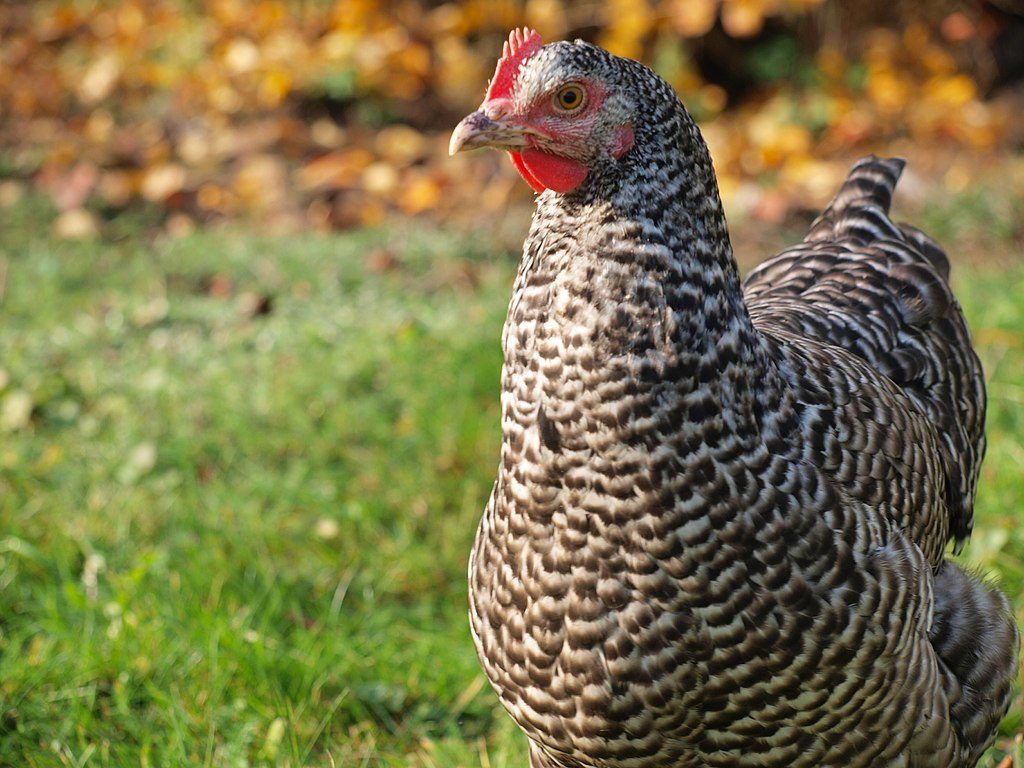
| Egg Production | 4 – 5 large brown eggs/week |
| Egg Laying Age | 5 – 6 months |
| Recommended Experience Level | Beginner |
| Cold/Heat Hardy | Cold Hardy/Fairly Heat-Hardy |
| Purpose | Dual Purpose |
| Temperament | Docile; gentle; friendly; calm; handles confinement fairly well |
| Size | Hens: 6.5 pounds; Roosters: 7.5 pounds; Bantam hens: 2.5 pounds; Bantam Roosters: 3 pounds |
| Origin | USA; APA Classification: American |
| Color | Barred, Blue, Buff, Columbian, Partridge, Silver-Penciled, White |
| Pricing | Chicks: $5 for hatchery chicks |
The Plymouth Rock is a popular bird found in backyard flocks worldwide. Docile and friendly, it’s an ideal breed for those just getting into chicken production. Although it is a dual-purpose bird, in recent years, some hatcheries have focused more on the egg-production qualities, often producing birds that are somewhat smaller than what you might find with a breeder’s stock.
Plymouth Rocks are hardy, reliable layers. They start laying at around 22 weeks of age and produce four to five large brown eggs per week.
The Plymouth Rock’s Distinct Features and Colors Offer Variety
The APA recognizes the Plymouth Rock in seven colors: barred, blue, buff, Columbian, partridge, silver-penciled, and white. The bantam Plymouth Rock offers the same colors plus a black variety. The barred feathers are clear with a distinctive pattern.
The Plymouth Rock has a single comb with five points. The comb, earlobes, and wattles are red, as is the area surrounding the eyes. The shanks are clean and the skin is yellow.
Plymouth Rocks are Excellent for Both Eggs and Meat on the Homestead
Plymouth Rock hens weigh 6.5 pounds and the roosters weigh 7.5 pounds, though some will grow larger than that. They make excellent roasters. Bantam Plymouth Rock hens weigh 2.5 pounds and the roosters weigh 3 pounds, making these birds among the larger bantams available.
The Plymouth Rock is a highly reliable egg layer, producing 200 or more large brown eggs per year or four to five eggs per week. The White Rock may produce more eggs, on average, than do other Plymouth Rocks due to more intensive breeding for mass production.
This breed will stop laying while brooding in the spring, but they make up for that lost time by continuing to lay well into the winter.
Other Things Homesteaders Should Know About Plymouth Rocks
- Docile and Calm –The Plymouth Rock is a very calm, gentle bird so it’s a great choice for the novice. Roosters and hens are easy to handle.
- Good Forager –The Plymouth Rock is an active bird that likes to be out and about. These birds will eat pretty much whatever they can find, from bugs and worms to berries and baby mice. If you can’t create a large foraging area that is safe from predators, try an enclosed run or a chicken tractor that you can move each day so the hens have new territory to explore.
- Confinement/Ranging –The Plymouth Rock handles confinement well but be sure to give them plenty of room. They can turn to feather picking—pulling the feathers of their coop-mates—when they feel stressed. Providing extra space for them can reduce the stress levels so they’re less apt to do this.
- Escaping Predators –The Plymouth Rock gets around fairly well, so these birds can escape some predators. We’ve found them to be reasonably decent flyers but many predators can catch them so you’ll want to provide protection for them if they’re out and about. We’ve lost a couple of Plymouth Rocks to snakes and foxes.
- Fair to Good Brooders/Good Mothers –Plymouth Rocks are pretty good egg setters and are excellent mothers. They are quite content to hatch out other hens’ eggs and raise the babies as their own. Give them extra room—the more room they have, the less stressed they get. And more space allows them to get up and down off the nest a couple of times a day with less risk to the eggs.
- Cold Hardy/Fairly Heat Hardy –The Plymouth Rock is considered a cold-hardy bird. They can usually handle heat but be sure to provide shade and water at all times as well as good ventilation when confined.
- Cuddly –Many Plymouth Rocks become rather cuddly once they start laying. Before they reach the laying stage, they’re more variable in temperament, with some being more skittish than others. But once they start cranking out eggs, they relax and become much more approachable and friendly. Many even become lap chickens.
For the Homestead Plymouth Rock Breeder
We’ve done quite well with Plymouth Rock chicks acquired from commercial hatcheries. They are all-around excellent birds—easy to handle and good producers of both meat and eggs. If you aren’t planning to breed to standard, hatchery chicks will likely provide what you need.
13. Rhode Island Red Chickens
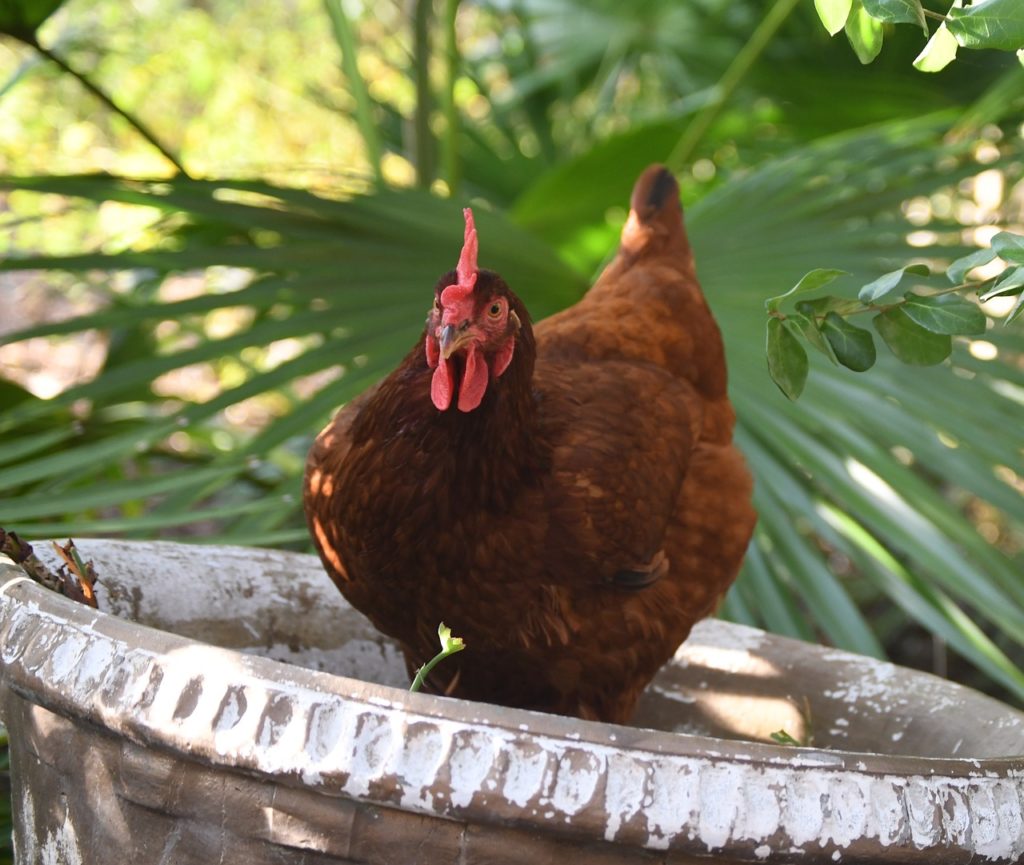
| Egg Production | 4 – 6 large light brown eggs/week |
| Egg Laying Age | 6 months |
| Recommended Experience Level | Beginner |
| Cold/Heat Hardy | Cold Hardy/Heat Tolerant |
| Purpose | Dual Purpose |
| Temperament | Hens are gentle, docile, friendly, and handle confinement well. Roosters can be aggressive. They are active birds |
| Size | Hens: 6.5 pounds; Roosters: 8.5 pounds; Bantam hens: 30 ounces; Bantam Roosters: 34 ounces |
| Origin | USA; APA Classification: American |
| Color | Red |
| Pricing | Chicks: $3 for an industrial hatchery chick; $4 to $8 for heritage birds. More for exhibition quality |
The Rhode Island Red is a highly popular dual-purpose bird that starts laying at six months old and produces four to six large light brown eggs per week. It is hardy, easy to handle, and an outstanding producer of eggs and quality meat.
The Rhode Island Red’s Distinct Features Make It a Homestead Standout
The Rhode Island Red has a proud, upright carriage and is red in color. The skin is yellow and the shanks are clean and yellow with a reddish tinge. The eye surrounds, earlobes, comb, and wattles are a deep red.
This breed has two versions because commercial breeders have emphasized egg production, leading to a bird that does not conform to the APA standard. The original heritage version is still available, however, thanks to the diligent work of Rhode Island Red devotees.
The heritage Rhode Island Red has a single or rose comb and is uniformly red in color. It lays a good number of eggs and produces excellent table quality meat. These Rhode Island Reds will brood and they are good mothers. Hens weigh 6.5 pounds and the roosters weigh 8.5 pounds.
The industrial/commercial Rhode Island Red is smaller, lays a few more eggs per year than does its heritage counterpart, and can vary in color from light red to red and black.
A bantam version of the Rhode Island Red is also recognized in the USA. Bantam roosters weigh 34 ounces and Bantam hens weigh 30 ounces.
Rhode Island Reds are hardy birds. They thrive on challenging conditions and can handle substandard feed and housing, though we do not recommend these conditions. They do well in many climates, are generally healthy, and are not prone to particular problems, though you should make dust bathing available to keep parasites at bay.
Other Things Homesteaders Should Know About Rhode Island Reds
- Docile and Calm Hens/Aggressive Roosters. The Rhode Island Red hen is a very calm, docile, gentle bird, ideal for the novice. The roosters, however, can be aggressive against humans and other birds.
- Active Forager. The Rhode Island Red is active and loves to forage.
- Confinement/Ranging. The Rhode Island Red handles confinement well but prefers free-ranging and spending its days foraging.
- Escaping Predators. Rhode Island Reds are not typically flighty but the smaller industrial version can often escape ground predators. Their smaller size may invite the attention of hawks and eagles, however. Regardless of which type you have, ensure that your free-ranging area is safe from predators.
- Somewhat Broody. Heritage Rhode Island Reds are more likely to brood than are their industrial counterparts. They will hatch out eggs from other hens. They make very good mothers and are happy to raise chicks of all types.
- Cold Hardy/Heat Tolerant. Rhode Island Reds are cold-hardy and heat tolerant. As with all birds, shelter should be available to ensure they can escape the worst of the heat or cold, but these birds do well in a wide range of temperatures and conditions.
- Friendly if not Cuddly. Rhode Island Reds are friendly and often follow their humans around the farm. Some hens welcome human lap time.
For the Homestead Rhode Island Red Breeder
If you want Rhode Island Red hens for egg production, both the industrial and heritage varieties produce plenty of eggs. The industrial version will produce a few extra per month, but yield far less meat. If you want your Rhode Island Reds to brood, heritage birds are more likely to sit on their eggs. Hatchery versus breeder makes a difference with this bird. If you want heritage qualities, the extra investment will really count. The good news is, heritage chicks won’t break the bank. If you have any interest in exhibiting Rhode Island Reds, hatchery birds are not for you. The industrial/commercial version of this bird will be disqualified for failure to meet the APA standard. Focus on reputable breeders who can provide heritage birds that meet the APA standard.
14. Sex-Link Chickens
| Egg Production | 5-6 large eggs/week, color varies |
| Egg Laying Age | 5-6 months |
| Recommended Experience Level | Beginner |
| Cold/Heat Hardy | Variable |
| Purpose | Dual Purpose |
| Temperament | Gentle; quiet; handles confinement well |
| Size | Hens: 6 to 7 pounds; Roosters: 8 to 9 pounds, some variation |
| Origin | — |
| Color | Variable |
| Pricing | Chicks: $3 – $5 from hatcheries |
The sex-link is not an actual APA-recognized chicken breed. It is a hybrid bird that has a special characteristic: the newly hatched chicks can be sorted by gender based on the coloring of their feathers. This is a pragmatic convenience that many have come to appreciate—a foolproof way to select baby chicks by sex.
There are several advantages to being able to identify a chick’s gender by feather color alone. First, there is no need for checking the chick’s vent. Vent checking requires a trained person to inspect the interior of the chick’s vent physically, a process can stress the tiny chick. Second, identification of these birds is more reliable than those made through vent checking.
There are several varieties of sex-link chickens but the most common are the black sex-link (such as Black Stars) and red sex-link chickens (such as Red Stars or Golden Comets). Other varieties include Rhodebar, Legbar, Golden Buff, Red Shaver, ISA Brown, California White, and Cinnamon Queen, to name a few.
The Sex-Link’s Characteristics Make Them Good Homestead Birds
In addition to the color-sexing aspect of the sex-link, this type of bird is also fast-maturing and hens produce a lot of eggs. The meat is of good quality as well.
Many sex-link hens weigh around six pounds and roosters weigh about eight pounds. Weight varies with the underlying breeds used to produce the particular bird. Red and black sex-links have clean legs and a single comb but leg color and size of comb can vary.
Sex-links offer excellent feed to egg production efficiency but they only produce eggs for one to two seasons. Some have been known to experience problems with their ovaries that can only be repaired with expensive surgery, a choice that typically isn’t viable.
Other Things Homesteaders Should Know About Sex-links
- Docile and Calm. The sex-link is a very calm, gentle bird. Their docile nature makes this breed an exceptional choice for the novice who doesn’t mind replacing the flock every couple of years.
- Active Forager. The sex-link is fairly active and loves to forage.
- Confinement/Ranging. The sex-link handles confinement well. They can live in a coop or in a chicken tractor and can also free-range.
- Escaping Predators. The Sex-link is not typically an oversized chicken, so they can be at risk with hawks and eagles. Other predators may target them as well. Though they enjoy free-ranging, you’ll want to ensure that their forage area is safe from predators.
- Not Brooders. Sex-link hens produce five or six eggs per week. They aren’t given to brooding so their egg production rate remains high until they stop producing after two years or so.
- Cold Hardy/Fairly Heat Tolerant. The cold-hardiness and heat tolerance of sex-link chickens vary with each cross. Our sex-link hens have done fairly well in both cold and heat, but we supply extra deep bedding and a draft-free coop in winter and keep fans running in the coop full time during the summer. The birds spend quite a bit of their summer days lying in the shade, dust bathing under the coop, and foraging in an enclosure.
- Friendly, Can be Cuddly. Sex-links raised with lots of handling as chicks can be rather cuddly as adults. If they aren’t handled much when young, they’re still friendly but less apt to approach you like a pet.
Sex-Links For the Homestead
Sex-link chickens are hybrids so they do not breed true, i.e. produce offspring with the same characteristics. Most people buy female chicks, harvest the plentiful eggs for about two years, then replace the depleted hens with new chicks.
Whether you want sex-links in your flock is a matter of personal choice. There are some ethical considerations. These are dual-purpose birds, so you would think people would buy plenty of young male chicks to raise for meat. But given the choice, people tend to go with the heavier meat breeds like the Cornish and the Cornish Cross if they are raising birds specifically for meat. The result? People buy female sex-link chicks and many of the young male chicks are discarded when they don’t sell.